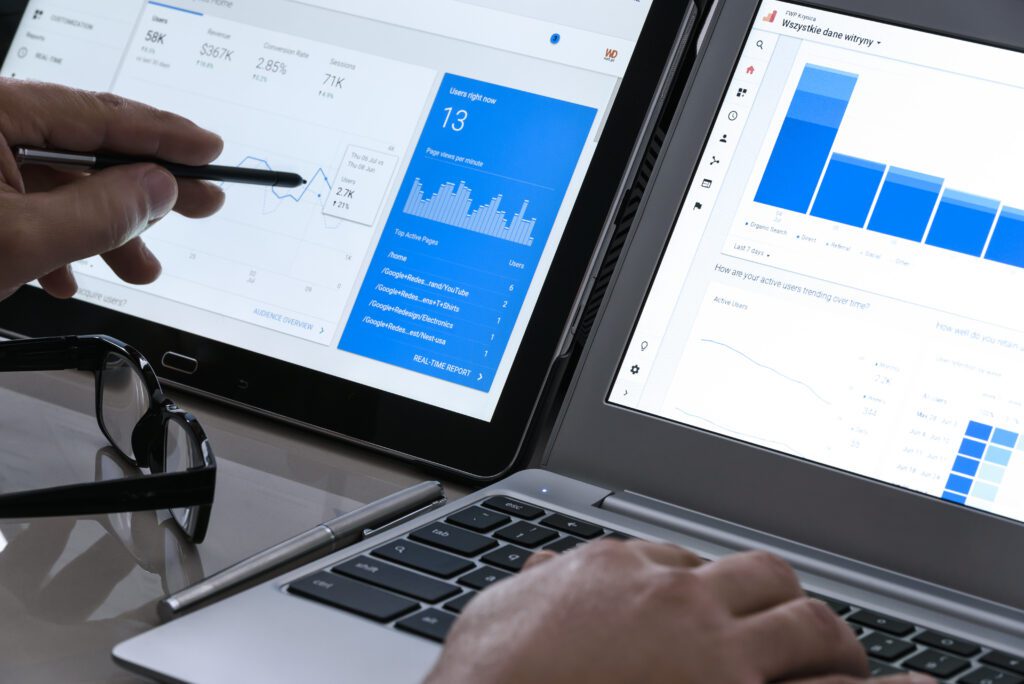
What Makes Up Your Optimization Score in Google Ads & Why It Matters?

Optimizing your Google Ads campaigns is essential for success in the digital marketing realm. An optimization score is a metric used to measure your campaign performance and can help you identify areas that need improvement. In this blog post, we’ll discuss what makes up an optimization score, why it matters, and strategies you can use to improve it. We’ll also provide examples of successful campaigns that have leveraged these strategies to increase their optimization scores and offer tips on tracking and analyzing data from your campaign performance so you can further optimize your ads over time.
Table of Contents:
- Factors that make up an optimization score
- Improve your optimization score with strategies
- Examples of successful campaigns
- Importance of optimizing your Google Ads campaigns
- Tips on tracking and analyzing data from your campaign performance to further optimize your ads over time
- Final Thoughts
Factors that make up an optimization score
Google Ads campaigns are essential for success in the digital marketing realm, and an optimization score is a key metric used to measure how well those campaigns are performing. Optimization scores allow you to identify areas of improvement and address any issues before they become too costly or time-consuming. It’s important to understand what makes up an optimization score, why it matters, and how to leverage it to improve your campaign performance.
An optimization score is composed of several factors, including budget rates, target audience reach, ad quality, ad relevance, and user experience. Budget rate measures total expenditure versus projected cost per click (CPC), while target audience reach indicates the effectiveness of targeting options in reaching the desired customer base. Ad quality focuses on keyword selection, bidding levels, and copywriting accuracy; ad relevance evaluates how closely related an advertisement is to the search query; and user experience looks at click-through rates (CTR) as well as post-click conversion rates.

Knowing your optimization score can help you make more informed decisions regarding improving your Google Ads campaigns. Tracking changes in your optimization score over time can help you identify patterns that will guide future improvements or areas where additional resources may be needed. Analyzing successful campaigns can give you insights into creative strategies that work for your own campaign goals.
For example, if a competitor’s campaign has higher optimization scores than yours due to better CTRs or stronger ad relevance, you’ll know where to prioritize efforts when looking for ways to improve your own campaigns. When tracking and analyzing data from past campaigns, look at all of the components that make up an optimization score rather than just focusing on one particular area, such as CPC or CTR. All aspects should be considered together, as any changes in one area can affect another component of the score. Consider measuring different KPIs like cost per result or return on investment (ROI) instead of solely relying on optimization scores – this approach allows you to dive deeper into each metric and gain more insight into their impact on overall performance.
Improve your optimization score with strategies
Various factors determine an optimization score, and it’s important to understand them to make a well-informed decision. Here are some strategies that you can use to optimize your Google Ads account and improve your score:
1. Use Automation Strategies:
Automation strategies like automated rules, bid strategies, scripts, etc., can be used to save time, optimize performance at scale, and quickly take action on changes within the account without manual intervention. Automation strategies help keep your account organized and reduce mistakes that could lead to lower scores.
2. Monitor Campaign Performance Regularly:
Keeping track of the performance metrics like CPC (cost per clicks), CTR (click-through rate), CPA (cost per action) goals, etc., regularly helps you identify underperforming campaigns quickly and make necessary changes to stay ahead of competitors. In addition, monitoring campaign performance helps ensure that every aspect of campaign management aligns with goals such as improved cost per click (CPC), conversions, or Return On Ad Spend (ROAS).
3. Optimize Keyword Targeting:
Keywords are essential in improving quality scores for ads on Search Engines Result Pages (SERPs). It’s important to constantly review keyword targeting to ensure that only relevant keywords are being targeted for each ad group or campaign. This will help filter out irrelevant search queries from receiving impressions (and clicks!) from paid search ads which could lead to lower optimization scores if left unchecked for long periods.
4. Utilize Negative Keywords:
Negative keywords are just as important as positive keywords. Adding negative keywords helps reduce wasteful spending by preventing ads from showing up against searches containing those unwanted terms or phrases, thus eliminating irrelevant clicks that don’t offer any value towards achieving marketing goals set out at the start of the campaign period.
5. Test New Ad Copy & Creative Assets:
Regularly testing new ad copy is important in optimizing accounts with higher scores in mind. Fresh creativity often results in more engagement from users. Leading up to improved click-through rates (CTRs) over time as long as proper tracking mechanisms are put into place for comparison purposes between different versions being tested against each other at any given time frame during a campaign period.
Similarly, testing creative assets like images or videos help keep interest alive among audiences who may have seen similar content multiple times over already. This leads them back onto SERPs (search engine result pages for another chance at engaging with the brand and its offerings resulting in better scoring opportunities provided everything else stays equal!
Examples of successful campaigns
One of the most successful campaigns that have used these optimization strategies is the campaign implemented by Audi. The luxury car brand initially aimed to increase brand awareness amongst its target audience and drive more sales. To achieve this goal, they utilized A/B testing to compare different versions of the same ad and optimize their ad copy. Through this process, they were able to find the most effective variation that chimed with their target audience.
Additionally, they conducted keyword research to identify which keywords would draw in potential customers looking for luxury cars. As a result, Audi increased traffic and conversions on their website by utilizing high-converting keywords in their ads.
Finally, they also leveraged powerful ad copywriting techniques to craft compelling ads that successfully grabbed users’ attention and encouraged them to click through and visit Audi’s website. All these efforts resulted in a significant improvement in Audi’s optimization score and an increase in sales numbers. Their campaigns proved successful both domestically and overseas as it allowed them to reach a much larger audience by increasing visibility within the search engine results pages (SERPs). This was essential for establishing their presence within Google Ads and putting their brand firmly on the map for potential customers around the world.
As a testament to the effectiveness of this campaign, Audi has seen an increase of over 15% in its organic search traffic since implementing these optimization strategies into its campaigns.
There have been other various case studies showing how these strategies have been used together effectively, resulting in successful campaigns with great returns on investment (ROI), such as Nike’s “Just Do It” google search campaign targeting athletes, which resulted in 30% increase in traffic within 24 hours and Volkswagen’s display advertising campaign aimed at changing customer perceptions about VW vehicles leading to six million clicks worldwide within two weeks of launch.
These examples show us just how much potential there is when creating campaigns targeting specific audiences using advanced techniques focusing on optimizing all components of the overall optimization score effectively, resulting in great ROI for advertisers who put thought into their strategies before launching campaigns – something worth considering no matter what type of advertising budget you may have available!

Importance of optimizing your Google Ads campaigns
Optimizing your Google Ads campaigns is essential for achieving desired results and an excellent ROI (return on investment). By implementing optimization strategies, businesses can increase visibility on SERPs and reach out to more potential customers worldwide. As a result, companies that optimize their Google Ads campaigns have seen a significant increase in organic search traffic, which ultimately translates into higher profits and greater market share. It is important to note that optimizing your ads involves:
- Careful consideration of the right keywords
- Ad performance tracking
- Understanding the customer journey
- Creating effective ad copy
- Testing different variations of the same ad
- Monitoring changes in the marketplace
- Making necessary adjustments to stay competitive
These are just a few optimization tactics businesses can employ to ensure their ads reach the right audiences at the right time. In addition to using these optimization strategies, businesses should also use analytics tools such as Google Analytics or AdWords Conversion Tracking to track how visitors interact with their ads once they click through on them. This data can help businesses better understand how visitors respond to their ads and make any necessary adjustments or improvements based on insights derived from analytics data. Additionally, companies should constantly look for areas of optimization, such as landing page design or targeting, to ensure maximum engagement from all potential customers.
Tips on tracking and analyzing data from your campaign performance to further optimize your ads over time
Tracking and analyzing data from your Google Ads campaigns can be challenging, but it is essential to improving your optimization scores over time. Understanding what is working and what needs improvement helps identify areas where you can make adjustments or optimizations to improve results. It is important to set up tracking capabilities before launching a campaign so that you can monitor activity on an ongoing basis and take action when necessary. Tracking tools like AdWords provide insights into various metrics, including CTR, impressions, conversion rates, cost per conversion, average position in search results pages (SERPs), etc.
Additionally, conducting regular Search Query Reports (SQRs) is beneficial to further optimize your ads over time. These reports show specific search queries related to keywords for which users see or click on ads associated with those keywords. Analyzing these reports provides valuable insight into user intent, identifying patterns in terms of what people are searching for when they engage with your ads or even reporting any unexpected searches which could be detrimental to performance if left unchecked. Google Ads also offers automated bid strategies that allow advertisers to adjust bids automatically according to changes in their goals or other criteria that they specify. While they can be effective in helping you reach certain objectives faster than manual bid adjustments alone, they should be used deliberately, as there are still some pitfalls associated with them. For example, such as inadvertently increasing bids too much, outstripping budget restrictions, or unnecessarily limiting reach by lowering bids too drastically when more flexibility may yield better results in certain cases. Analyzing all relevant data points is critical for successful optimization efforts; this includes external factors like industry trends and internal ones related directly to campaign performance, such as CTRs or CPCs.
Doing this regularly allows advertisers to make informed decisions about their strategies over time rather than simply relying on standard tactics. Proper consideration for actual results by campaigns in real-life scenarios ensures maximum effectiveness from every dollar spent on PPC ads — ultimately resulting in higher returns on investment.

Final Thoughts
The Optimization Score is one of the most critical metrics in Google Ads. It measures how well your campaigns are performing and can help you identify areas where you need to improve. Optimization Score evaluates all aspects of your account performance, including ad relevance, keyword quality, bids, budgeting, and more. By understanding what makes up your Optimization Score and why it matters, you’ll be able to make better decisions that will help increase your overall campaign performance.
At Two Trees PPC, we understand the importance of Optimization Score and will work with you to create and maintain a successful Google Ads campaign that meets your goals. We provide detailed analyses of your current campaigns and make recommendations on how to improve them for better results. Our team also keeps track of changes in the industry so that we can stay up-to-date on the latest trends and ensure your campaigns are optimized to maximize your reach. With our expertise, you can be confident that your website is fully optimized and ready to take off in the SERPs.
From keyword research to Google Ads optimization and beyond, Two Trees PPC has the right solutions for you. Contact us today and let’s get started on your web presence journey. Our team is dedicated to helping you reach your goals and grow your business. Together, we can make sure your website stands out from the rest.


